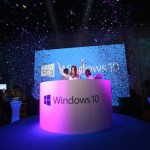
No queues formed at midnight for the first copies. Nobody rushed home to install the latest Windows 10, out yesterday.
Instead, most users got their new Windows downloaded right onto their PCs – for free. Many more will get it in the coming weeks and months when they buy a new PC.
After decades of glitzy, high-profile launches, Microsoft has done the unthinkable by releasing the latest version of Windows free to most end users.
Okay, PC makers still pay licensing fees for copies sold on their PCs, while PC enthusiasts also have to buy new copies for new self-built machines.
But the rather low-key launch for Windows 10 this time marks the passing of an era for the PC software giant. As it faces a crossroads after 30 years of selling Windows to every PC sold on the planet, it has been forced to find new paths to survive in a tough environment.
Instead of charging the maximum that users could bear for each copy, Microsoft will use Windows 10 to get as many users on its new services as possible. That means giving away the software to end users – mostly.
Whether that will work is another matter, of course. The stated aim is to get these users to spend on other things besides the upfront cost of Windows. Services is a buzzword today, and Google and Facebook have been there earlier, despite the dominance of Windows all this while.
Could add-ons and services be the next big thing to fuel Microsoft’s ambitions in the years ahead? Well, it has to begin somewhere to get to its target of one billion Windows 10 devices by 2018.
Interestingly, to get the full Solitaire experience on Windows 10 – sans advertisements – you’ll have to pay US$1.49 a month for a premium version. That may be a preview of what else you’d have to pay with the “free” operating system in future.

The big question is whether Microsoft can achieve the same stickiness that its rivals have had with their services. Google has search and Gmail as indispensibles to everyday life, while Facebook’s social appeal is obvious.
Microsoft? It can’t be charging people too much for Windows if it wants the software to be pervasive. Of all its service offerings, besides Skype which it bought over in 2011, none has gained the same pervasiveness as its rivals.
Will giving away Windows make people love Microsoft more? Well, it goes some way to make its software – and services – easy to adopt.
Don’t forget that in Windows 10 is a copy of Edge, the new Web browser that takes over from Internet Explorer after 20 years. This online entry point for many users can help make Bing, Microsoft’s search engine, more popular.
Perhaps more importantly, Windows 10 has given users what they want. Yes, the much-talked about Start bar is back, sort of.
Now, users can get into their familiar Windows desktop easily, unlike with Windows 8 which forced them to switch between a touch-friendly interface and the traditional desktop. It seems Microsoft has listened to customers.
That’s probably the reason why Windows 10 has earned good reviews early on. Yes, there are many other new features, such as improved security and the ability to “stream” games from an Xbox to a PC, but ultimately Microsoft has seen that the more you change, the more you stay the same.
In trying to remain the software behemoth of the PC era, it was finding itself out-fought in online services and in the basic operating systems that run devices from smartphones to PCs.
With Windows 10, a version of which will also be rolled out to mobile devices later this year, the company is seeking to win over users like never before. It has done so by going back to what users liked about Windows.
The result is one of the most polished and well-liked operating systems in years – at least at launch. Despite the lack of queues to buy it, Windows 10 may be the most popular yet.






